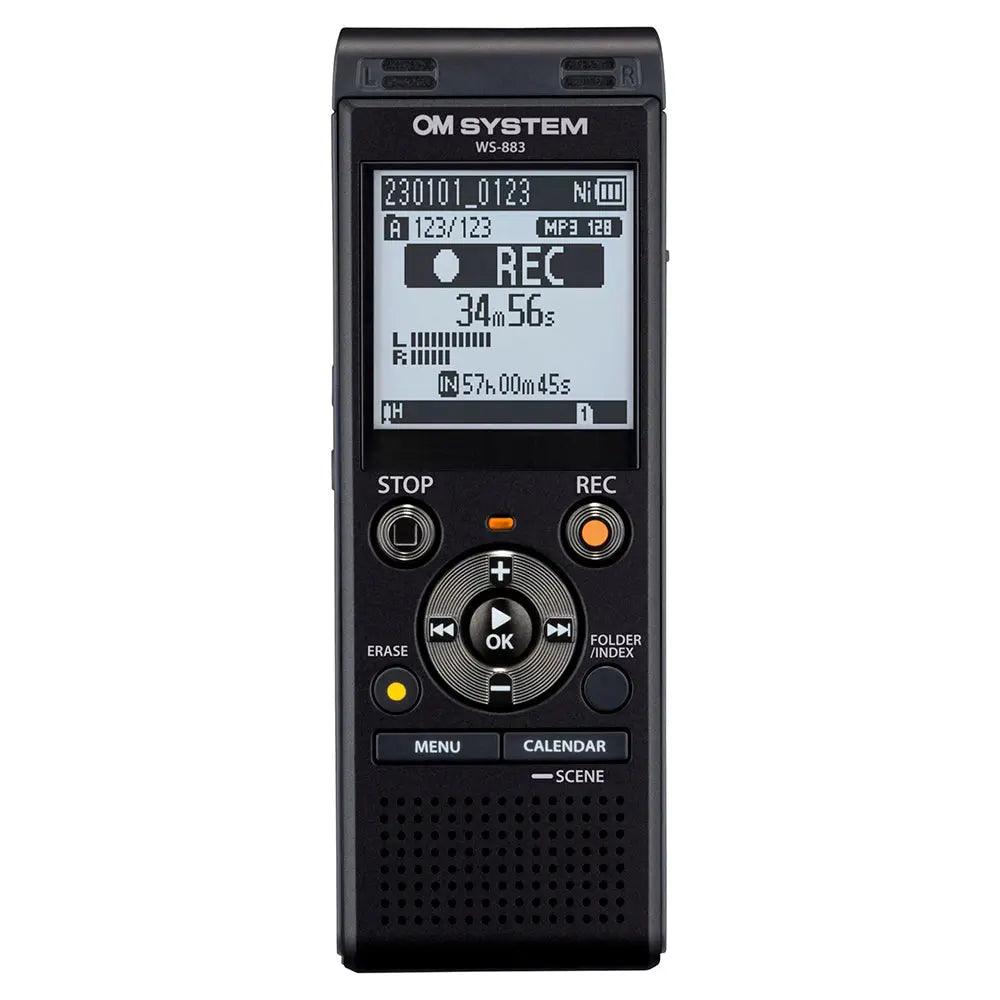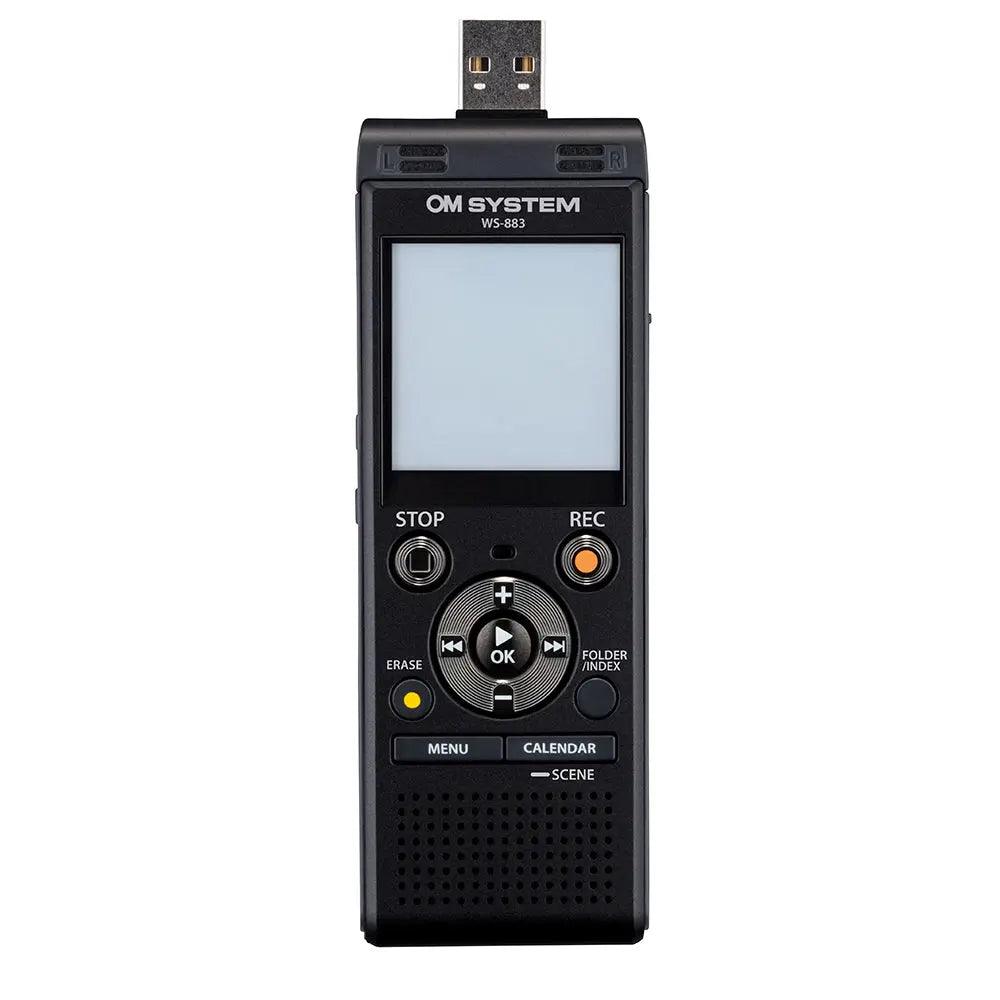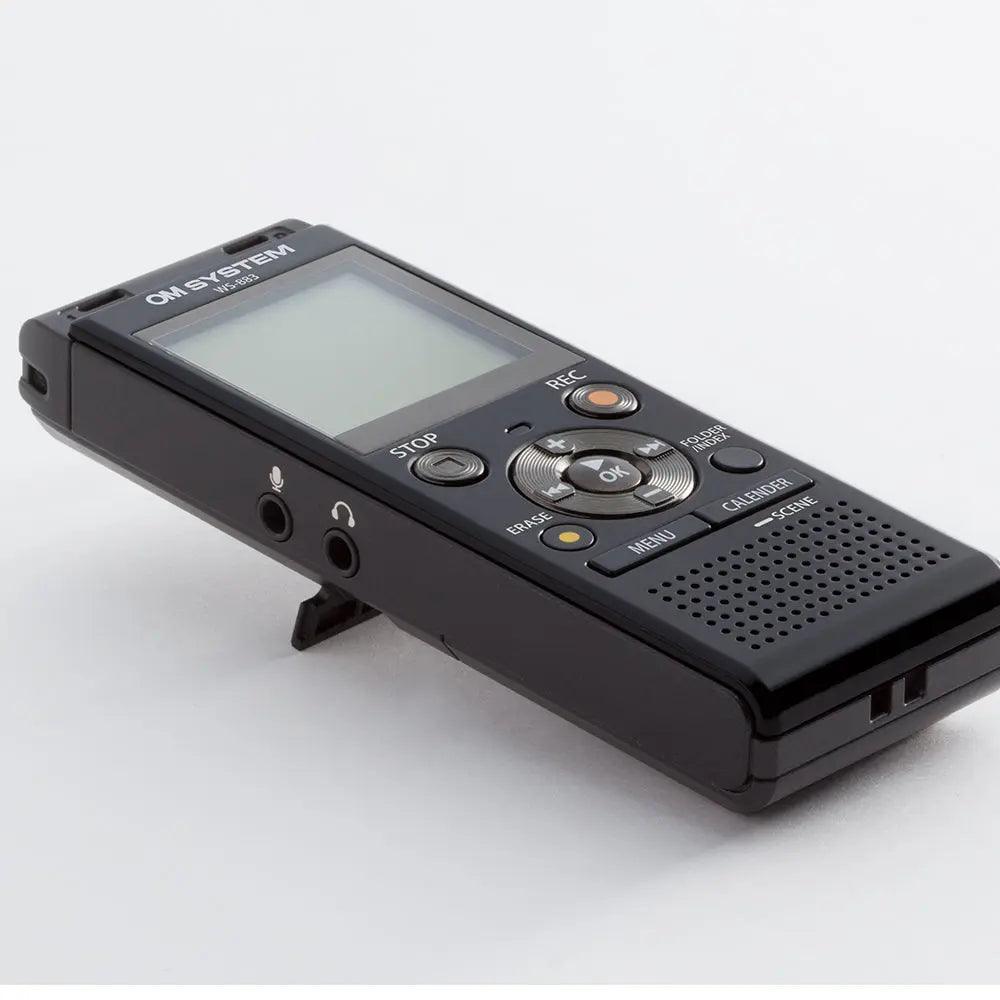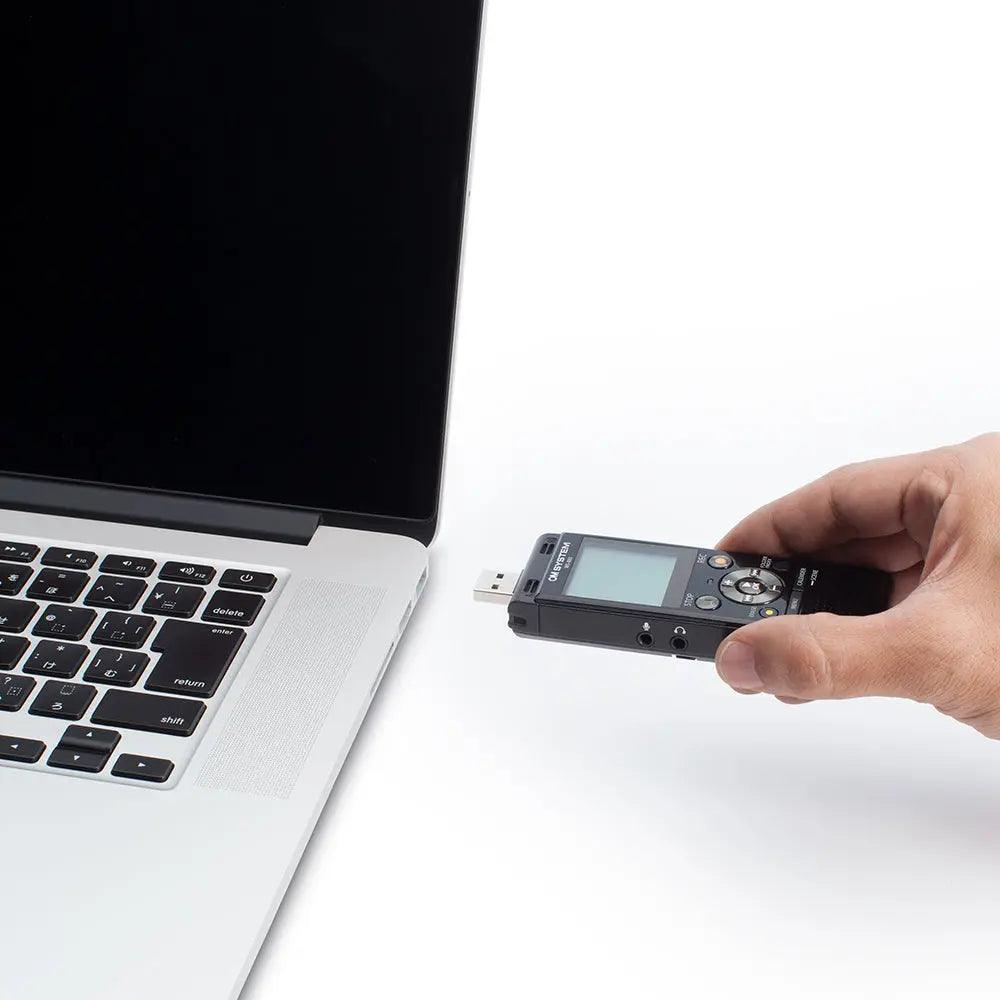



New Olympus WS-883 voice & music recorder
The Olympus WS-883. 8GB for up to 2080 hours of recording! LI-ION rechargeable batteries.
The Olympus WS-883. It is an IC recorder equipped with recording and playback functions that are full of useful functions. In addition to convenient functions such as "Voice Chaser" that automatically records at the optimum recording level and "Voice Changer" that allows you to play at intervals that do not tire your ears, language learning such as "fast listening / slow listening playback" and "shadowing" There are also many functions that are useful for learning. In addition to being able to store a large number of audio files for language learning, it is less likely to run out of space even when recording long meetings continuously, so you can use it with more peace of mind. This Olympus WS-883 recorder can be used for a wide range of purposes, from recording lectures and language learning to business.
High quality recording
Equipped with a variety of recording functions, the Olympus WS-883 can record in easy-to-hear sound, whether in a lecture in a large classroom or in a language conversation class for one-on-one lessons.
An impressive array of playback functions
The device has a full range of play-back functions, including a "Voice bal-ancer" that makes it easier to hear dis-tant voices, and a "Noise cancellation" function that suppresses excess noise. It also includes features that expand the range of usage scenarios, such as a useful mode for language learning that supports listening and learning.
Superb stereo feeling with True Stereo Microphones
Two low-noise directional microphones positioned at a 90° layout enables high quality recording in a realistic stereo feeling. This feature ensures that you capture even the di-rection and the distance of the speakers in a meeting.
Low-cut filter eliminates extraneous noise

During recording, the low-cut filter is used to cut the sound at frequencies of 300 Hz and lower, typical examples being the sound of air conditioner or projector fans. This filter also proves effective when recording with wind blowing outside. By cutting the lower frequency during recording ensures natural sounding without distortion while playback. You can select ON or OFF according to your option.
Automatic sensitivity adjustment with Intelligent Auto Mode
The Intelligent Auto Mode function automatically adjusts the microphone sensitivity ac-cording to the input level. For example, when you record the voice of a person far away in a large meeting room, the input level tends to be lower. For this case, the recorder au-tomatically raises the sensitivity of the microphone making them easier to hear. On the other hand, when you record in a smaller meeting room with only a few people, the sen-sitivity is automatically lowered, so that the voice of the speakers close by do not sound too loud. In this way, the function automatically keeps track of the input level and simul-taneously adjust the recording level so that it always record in the best quality. This en-sures that the recording remains consistent not having speakers too quiet or too loud. To set this function, simply select "Auto" for the recording level from the menu. When low, the sensitivity is raised When high, the sensitivity is lowered
- If you select "Meeting" for the recording scene while in Simple Mode, Intelligent Auto Mode is activated.

- When low, the sensitivity is raised

Specifications
Recording formats
| Recording formats | MP3 format |
|---|
Sampling frequency
| Linear PCM format | 22.05kHz sampling 16bit monaural |
|---|---|
| MP3 format | 128 kbps:44.1 kHz 64 kbps mono:44.1 kHz 8 kbps mono:11.025 kHz |
Maximum headphone output
| Maximum headphone output | Less than 150 mV (conforms to EN 50332-2) |
|---|
Recording media
| Internal NAND flash memory | 8GB(WS-883) 4GB(WS-882) |
|---|---|
| microSD card | 2GB to 32GB |
- Some recording media memory capacity is used as a management area, so the actual usable capacity will always be slightly less than the displayed capacity.
Speaker
| Type | Built-in 20 mm diameter round dynamic speaker |
|---|---|
| Maximum working output | 250 mW (8 Ω speaker) |
Jack
| Microphone jack | 3.5 mm diameter; Impedance: 2 kΩ |
|---|---|
| Earphone jack | 3.5 mm diameter; Impedance: 8 Ω or more |
Power source
| Standard voltage | 3 V |
|---|---|
| Battery | Two nickelmetal hydride rechargeable batteries(WS-883) Two AAA dry cell batteries(WS-882)
|
External dimensions / Weight / Operating temperature
| External dimensions | 111.5 mm × 39 mm × 18 mm
|
|---|---|
| Weight | 77g
|
| Operating temperature | 0 to 42°C(32 to 107.6°F) |
Frequency response
When recording from microphone jack
| Linear PCM format(22.05kHz mono) | 40 Hz ~ 11 kHz |
|---|---|
| MP3 format | 128 kbps:40 Hz ~ 17 kHz 64 kbps mono:40 Hz ~ 15 kHz 8 kbps mono:40 Hz ~ 3.5 kHz |
When recording with built-in microphone
| When recording with built-in microphone | 70Hz ~ 17 kHz
|
|---|
During playback
| During playback | 30Hz ~ 20kHz
|
|---|
Battery life (When recording with built-in microphone)
| Linear PCM format(22.05kHz mono) | When using alkaline battery: Approx. 53 hours When using NiMh battery: Approx. 32 hours |
|---|---|
| MP3 format(128 kbps) | When using alkaline battery: Approx. 41 hours When using NiMh battery: Approx. 30 hours |
| MP3 format(64 kbps mono) | When using alkaline battery: Approx. 48 hours When using NiMh battery: Approx. 31 hours |
| MP3 format(8 kbps mono) | When using alkaline battery: Approx. 110 hours When using NiMh battery: Approx. 68 hours |
- The battery life figures shown here were determined using an Olympus test method (When [LED] is set to [Off]). Actual battery life figures will vary greatly according to the battery used and usage conditions (Changing the playback speed, or using the [Noise Cancel] and [Voice Balancer] functions may affect the battery life).
- Battery life will be shorter when using a nickel-metal hydride rechargeable battery that has been used repeatedly.
- Battery life will be shorter when using a microSD card.
Battery life (During speaker playback)
| Linear PCM format(22.05kHz mono) | When using alkaline battery: Approx. 15 hours When using NiMh battery: Approx. 11 hours |
|---|---|
| MP3 format(128 kbps) | When using alkaline battery: Approx. 15 hours When using NiMh battery: Approx. 11 hours |
| MP3 format(64 kbps mono) | When using alkaline battery: Approx. 15 hours When using NiMh battery: Approx. 11 hours |
| MP3 format(8 kbps mono) | When using alkaline battery: Approx. 24 hours When using NiMh battery: Approx. 16 hours |
- The battery life figures shown here were determined using an Olympus test method (When [LED] is set to [Off]). Actual battery life figures will vary greatly according to the battery used and usage conditions (Changing the playback speed, or using the [Noise Cancel] and [Voice Balancer] functions may affect the battery life).
- Battery life will be shorter when using a nickel-metal hydride rechargeable battery that has been used repeatedly.
- Battery life will be shorter when using a microSD card.
Battery life (During earphone playback)
| Linear PCM format(22.05kHz mono) | When using alkaline battery: Approx. 73 hours When using NiMh battery: Approx. 53 hours |
|---|---|
| MP3 format(128 kbps) | When using alkaline battery: Approx. 70 hours When using NiMh battery: Approx. 49 hours |
| MP3 format(64 kbps mono) | When using alkaline battery: Approx. 73 hours When using NiMh battery: Approx. 53 hours |
| MP3 format(8 kbps mono) | When using alkaline battery: Approx. 92 hours When using NiMh battery: Approx. 64 hours |
- The battery life figures shown here were determined using an Olympus test method (When [LED] is set to [Off]). Actual battery life figures will vary greatly according to the battery used and usage conditions (Changing the playback speed, or using the [Noise Cancel] and [Voice Balancer] functions may affect the battery life).
- Battery life will be shorter when using a nickel-metal hydride rechargeable battery that has been used repeatedly.
- Battery life will be shorter when using a microSD card.
Recording time
Linear PCM format
| Internal memory | Approx. 47 hrs 15min(WS-883) Approx. 23 hrs 40min(WS-882) |
|---|---|
| microSD card (32GB) | Approx. 191 hrs |
| microSD card (16GB) | Approx. 95 hrs |
| microSD card (8GB) | Approx. 47 hrs |
MP3 format
| Internal memory | 128 kbps:Approx. 130 hrs(WS-883) Approx. 65 hrs(WS-882) 64 kbps mono:Approx. 260 hrs(WS-883) Approx. 130 hrs(WS-882) 8 kbps mono:Approx. 2080 hrs(WS-883) Approx. 1040 hrs(WS-882) |
|---|---|
| microSD card (32GB) | 128 kbps:Approx. 530 hrs 64 kbps mono:Approx. 1060 hrs 8 kbps mono:Approx. 8480 hrs |
| microSD card (16GB) | 128 kbps:Approx. 264 hrs 64 kbps mono:Approx. 525 hrs 8 kbps mono:Approx. 4220 hrs |
| microSD card (8GB) | 128 kbps:Approx. 132 hrs 64 kbps mono:Approx. 264 hrs 8 kbps mono:Approx. 2110 hrs |
- Actually available recording times may be shorter than the figures shown here when making short recordings repeatedly (Equipment displays of available/elapsed recording times should be considered guideline values).
- Available recording time will also vary due to differences in the available memory capacity of different microSD cards.
Maximum recording time per file
Linear PCM format
| Linear PCM format(22.05kHz mono) | Approx. 12 hrs |
|---|
MP3 format
| 128 kbps | Approx. 74 hrs 30 min |
|---|---|
| 64 kbps mono | Approx. 149 hrs |
| 8 kbps mono | Approx. 1193 hrs |
- The maximum file size is limited to about 4 GB in the MP3 format.
- Regardless of the amount of remaining memory, the maximum recording time per file is restricted to the following values.
- Note that voice recorder specifications and appearance are subject to change without prior notice for performance improvements or other upgrading.




